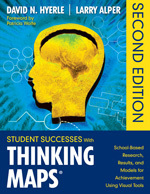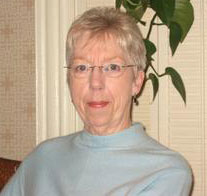



Thinking Maps®
Corwin Press, Second Edition, January 2011
David Hyerle and Larry Alper co-editors
 About the Book
About the Book
This unique professional book is a comprehensive documentation of the theory, practice and research behind Thinking Maps. There are 17 chapters offering research and results, grouped into four sections:
- Thinking, Language and Learning;
- Integrating Content and Process;
- Whole Learning Communities; and,
- Professional Development.
Read the forwards by Pat Wolfe, author of Building the Reading Brain, and Marti Richardson, President of National Staff Development Council below.
For more on Student Successes With Thinking Maps go to the following links:
What are Thinking Maps®?
Download Thinking Maps as a Transformational Language for Learning
Excerpt from Forward by Pat Wolfe, Author, Building the Reading Brain
The brain remembers what it has seen because humans are intrinsically visual beings. The eyes contain almost 70% of the body’s sensory receptors and send millions of signals every second along optic nerves to the visual processing centers of the brain…
T he Thinking Maps® program takes full advantage of the natural proclivity of the brain to see and think visually. The authors describe Thinking Maps as a language of visual tools grounded in the thinking process, a most neurally apt description. Neuroscientists tell us that the brain organizes information in networks and maps. What better way to teach students to think about ideas and organize and express their ideas than to use the very same method that the brain uses.
he Thinking Maps® program takes full advantage of the natural proclivity of the brain to see and think visually. The authors describe Thinking Maps as a language of visual tools grounded in the thinking process, a most neurally apt description. Neuroscientists tell us that the brain organizes information in networks and maps. What better way to teach students to think about ideas and organize and express their ideas than to use the very same method that the brain uses.
This book provides an invaluable way to help our students truly understand and retain the concepts behind the facts, and to do this in an exciting and motivating way.
Excerpt from Forward by Marti Richardson, President, NSDC
All students and staff members should have high quality learning on a daily basis. Student Successes with Thinking Maps® examines a series of vignettes which breathe life into this statement, presents a powerful argument for usin this tool at every level, and illustrates how students have systematically and deliberately taken charge of their own learning via the transformational power of Thinking Maps. Following a presentation of the “what, why, and how” of Thinking Maps, the reader is treated to a panoramic view into schools that have successfully used this unique tool kit to bridge the gap from research to practice. All are worthy models to examine—and follow—as schools focus on continuous growth for all through individual and school improvement. The book is a must read!
![]() Click here (pdf file) to download Research Highlights from
Click here (pdf file) to download Research Highlights from
Student Successes With Thinking Maps
For more on Student Successes With Thinking Maps go to the following links: